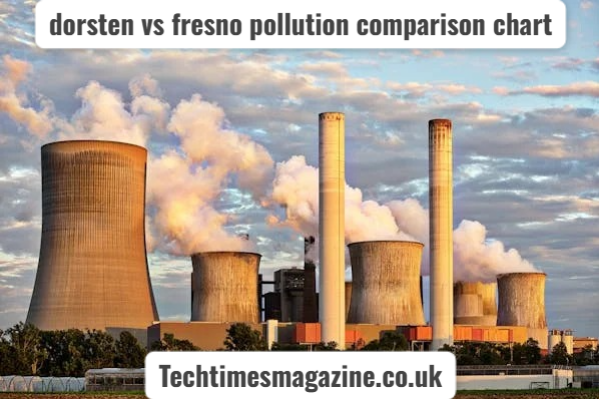
Air pollution has become one of the most pressing issues of the modern era, with urban and rural areas alike grappling with declining air quality. The need to compare pollution levels between cities like Dorsten, Germany, and Fresno, California, has gained traction due to public health concerns, climate change debates, and urban sustainability goals. People often seek this data to determine where to live, how to travel more responsibly, or to better understand the scope of global environmental challenges. This article provides a comprehensive, fact-based comparison of air quality and pollution statistics between Dorsten and Fresno dorsten vs fresno pollution comparison chart through structured data, real-world examples, and a clear analytical lens.
Geographical Overview: Dorsten and Fresno at a Glance
Dorsten is a small town located in North Rhine-Westphalia, Germany, known for its green spaces, moderate population density, and regulated industrial activities. In contrast, Fresno lies in California’s San Joaquin Valley and is home to a larger, more diverse population with substantial agricultural and urban activities. The geography plays a crucial role in determining the air quality of both cities. Dorsten benefits from European Union environmental regulations and prevailing winds that help dissipate pollutants, while Fresno’s basin-like topography tends to trap air pollutants, especially during summer and winter inversions.
Major Sources of Pollution in Dorsten
Dorsten’s pollution sources are relatively limited and well-regulated. The town has some manufacturing units and transportation-related emissions, but strict EU policies cap the amount of pollutants released. Air monitoring stations in Dorsten typically report lower levels of PM2.5 and NO2 compared to major German cities. One of the biggest factors keeping Dorsten’s pollution under control is the wide presence of green belts and urban forests, which naturally filter the air. Renewable energy sources are also on the rise in this region, contributing to a cleaner environmental profile.
Major Sources of Pollution in Fresno
Unlike Dorsten, Fresno struggles with several complex and overlapping sources of air pollution. The city’s location in a valley surrounded by mountains prevents pollutants from dispersing easily. Vehicle emissions, especially from diesel trucks on major transport routes like Highway 99 and I-5, contribute significantly to air degradation. In addition, Fresno is at the heart of California’s agricultural economy, and emissions from pesticide use, dust, and burning of agricultural waste are critical contributors. Wildfires, which have increased in frequency and intensity, further exacerbate the region’s pollution levels.
Air Quality Index (AQI) Data: Dorsten vs Fresno
To provide a clear visual understanding, the following table compares the average AQI values of Dorsten and Fresno over the past five years based on available government and international environmental databases.
| Year | Dorsten AQI (Avg.) | Fresno AQI (Avg.) |
| 2020 | 28 | 78 |
| 2021 | 26 | 85 |
| 2022 | 24 | 91 |
| 2023 | 27 | 88 |
| 2024 | 25 | 93 |
These figures indicate that Fresno consistently suffers from moderate to unhealthy air quality, while Dorsten remains within the “Good” AQI category throughout the year.
Comparing PM2.5 and PM10 Levels
Particulate Matter (PM) is one of the most dangerous pollutants for human health. PM2.5 refers to particles smaller than 2.5 microns, which can deeply penetrate lung tissue and even enter the bloodstream. Dorsten reports PM2.5 levels usually ranging from 5 to 15 µg/m³, aligning with the World Health Organization’s recommended thresholds. Fresno, on the other hand, often reports values exceeding 35 µg/m³ during peak seasons, sometimes reaching hazardous levels during wildfire outbreaks or smog days. PM10 levels also show similar trends, indicating a higher respiratory risk for Fresno’s population.
Health Impacts Linked to Pollution Exposure
Long-term exposure to polluted air increases the risk of cardiovascular diseases, lung cancer, and respiratory conditions like asthma and bronchitis. In Fresno, children and the elderly are especially vulnerable due to the constant exposure to fine particulate matter. Studies have shown a significantly higher incidence of asthma in Fresno compared to other Californian cities. Dorsten, with its lower pollution levels, reports fewer cases of pollution-related illnesses. The presence of widespread healthcare initiatives and pollution awareness programs further mitigates risks in Dorsten.
Seasonal Variations in Pollution
Pollution patterns in both cities fluctuate throughout the year. In Fresno, winter inversions trap pollutants close to the ground, while summer brings ozone spikes due to intense sunlight reacting with vehicle emissions. Wildfires from surrounding regions also contribute to summer pollution. Dorsten experiences slight increases in pollution during winter due to heating but generally maintains stable levels year-round thanks to regulated industrial output and weather patterns that favor pollutant dispersion.
Environmental Policies and Enforcement
Environmental regulation is a crucial differentiator. Dorsten, being under the EU’s Green Deal and Germany’s strict environmental laws, benefits from policies promoting sustainable energy, green urban planning, and air quality monitoring. These laws are strictly enforced, and non-compliance results in severe penalties. Fresno, while governed by California’s progressive environmental laws, faces challenges in enforcement due to political resistance, industrial lobbying, and budget constraints. Agricultural exemptions and uneven application of environmental rules have weakened the impact of state-level initiatives.
Technological Monitoring and Public Awareness
Dorsten utilizes advanced EU-funded air quality monitoring systems with public access to real-time data. Citizens are regularly informed about pollution levels and educated on how to minimize their carbon footprints. Conversely, Fresno has recently upgraded its monitoring systems, but community access to real-time and actionable data remains limited. Public awareness is growing, but many still lack resources or incentives to change daily habits contributing to pollution.
Sustainable Transportation and Urban Planning
Public transportation in Dorsten is efficient and sustainable, with a strong emphasis on cycling and walking. Urban planning incorporates green spaces and environmentally friendly infrastructure. In Fresno, public transit is underdeveloped compared to European standards. Car dependency is high, and urban sprawl contributes to increased emissions. Though there are ongoing efforts to improve transit and develop bike lanes, these are still in nascent stages and face funding hurdles.
Wildfire-Related Pollution in Fresno
A unique and devastating contributor to Fresno’s pollution is wildfire smoke. In recent years, the Western U.S. has experienced more frequent and intense fires due to climate change. These fires contribute to spikes in PM2.5 levels, sometimes pushing AQI into the “hazardous” zone. Dorsten, in contrast, has not experienced such extreme natural events, giving it a natural advantage in long-term air quality consistency.
Community Engagement and Pollution Mitigation
Citizens in Dorsten participate in green initiatives such as tree-planting drives, energy-saving competitions, and recycling programs. These activities are often supported by local councils and schools. Fresno is seeing a rise in grassroots environmental activism, particularly in underserved communities most affected by pollution. Organizations like the Central California Asthma Collaborative are leading awareness and mitigation efforts but often face financial and bureaucratic limitation
Global Rankings and Perception
According to the IQAir 2024 Global Pollution Ranking, Dorsten is among the top 20 cleanest small cities in Europe. Fresno, however, has repeatedly been listed in the top 10 most polluted cities in the United States by the American Lung Association. These rankings influence public perception, investment decisions, and migration trends, with more environmentally conscious individuals gravitating toward cleaner regions.
Tabular Snapshot: Pollution Comparison Chart
| Metric | Dorsten (Germany) | Fresno (California) |
| Average AQI (2024) | 25 | 93 |
| PM2.5 Average (µg/m³) | 10 | 35 |
| Wildfire Impact | None | High (Seasonal) |
| Green Space Coverage | High | Low to Moderate |
| Public Transport Access | Extensive | Limited |
| Enforcement of Policies | Strong | Moderate to Weak |
Key Takeaways
- Dorsten has consistently lower pollution levels than Fresno.
- Fresno’s air quality suffers due to geography, wildfires, and agricultural emissions.
- Dorsten benefits from stringent environmental policies and community engagement.
- Public health in Dorsten reflects fewer pollution-related illnesses.
- Real-time pollution monitoring and transparency are stronger in Dorsten.
Conclusion: What the Data Really Tells Us
The comparison between Dorsten and Fresno reveals a stark contrast in air quality, pollution sources, and community impact. Dorsten stands out as a model for clean urban living, largely due to proactive environmental policies, efficient urban planning, and consistent community involvement. Fresno, though progressive in its intentions, struggles with systemic issues rooted in its geography, agricultural dependency, and uneven policy enforcement. While Fresno is making strides through activism and innovation, a lot remains to be done to match the clean air standards consistently maintained in Dorsten. For individuals looking to make informed choices about relocation, travel, or environmental advocacy, this comparison offers valuable insights rooted in real data and lived experiences.
Frequently Asked Questions
1. Why is Fresno more polluted than Dorsten?
Fresno’s pollution is higher due to its geographical basin trapping pollutants, heavy agricultural activity, wildfires, and underdeveloped public transit systems. Dorsten benefits from strict EU environmental policies and better urban planning.
2. How does Dorsten maintain cleaner air?
Dorsten maintains cleaner air through rigorous environmental regulations, extensive green spaces, renewable energy use, and community-driven sustainability programs.
3. Can Fresno improve its air quality to match Dorsten?
Yes, with sustained policy reform, investment in clean technologies, wildfire management, and stronger community involvement, Fresno can significantly improve its air quality in the coming decades.



